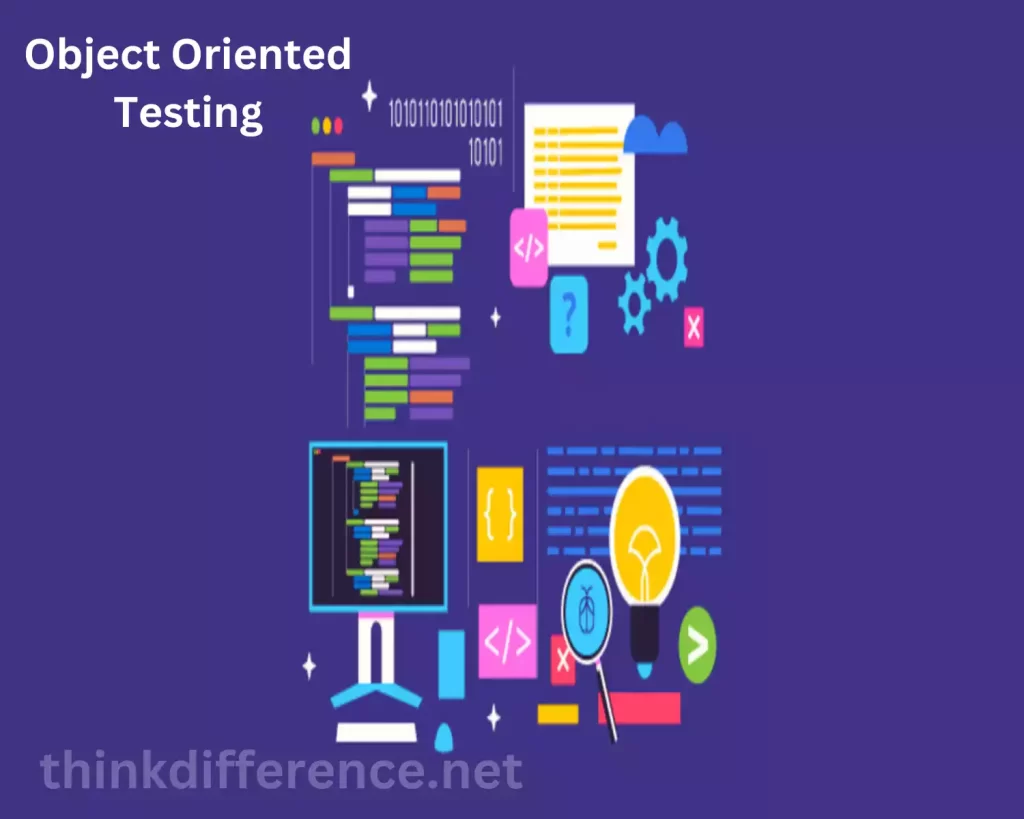Brief overview of Conventional and Object Oriented Testing
Conventional testing, also known as procedural testing or structured testing, is a traditional approach to software testing that follows a procedural or sequential execution model. In this testing methodology, the focus is primarily on the functional aspects of the software. Conventional testing techniques often involve writing test cases based on the functional requirements and systematically executing them.
Black-box testing is an efficient means of traditional software testing that involves testing software without knowing its internal structure, while white-box tests focus on understanding its logic and structure. Conventional testing is characterized by its simplicity and ease of use, making it suitable for small-scale projects with straightforward requirements. Testing requires established tools and practices.
Object-Oriented Testing as the name implies is a testing approach specifically developed for software that has been created using OOP principles. In this methodology, the emphasis is on objects and their interactions within the software system. Object-oriented tests take into account some fundamental concepts associated with OOP, such as encapsulation and inheritance.
Object-oriented testing techniques encompass class-level tests, which concentrate on individual classes and methods; integration tests which examine interaction among classes; inheritance-based tests which scrutinize behavior in classes descended from base classes; as well as inheritance tests which examine behavior among these. Object-oriented testing aims to ensure the reusability and modularity of code, as well as improved test coverage and fault detection.
Object-oriented testing offers advantages such as enhanced code maintainability and reusability, better test coverage due to consideration of inheritance and polymorphism, and improved scalability and flexibility. It requires specialized tools and frameworks that support object-oriented testing principles and techniques.
Conventional testing follows a procedural and functional-centric approach, focusing on sequential execution and traditional testing techniques. Object-oriented testing is tailored for object-oriented software development, taking into account object interactions, inheritance, and polymorphism, while aiming for code reusability, modularity, and improved test coverage.
Importance of Conventional and Object Oriented Testing

Importance of Conventional Testing:
- Identifying functional defects: Conventional testing helps in detecting functional defects and errors in software applications by verifying that the system functions according to the specified requirements. It ensures that the software meets the desired functionality and behaves as intended.
- Enhancing software quality: By thoroughly testing the software using conventional techniques, developers and testers can improve the quality of the product. Errors, bugs, and inconsistencies are reduced significantly resulting in more efficient software systems with greater stability and security.
- Ensuring user satisfaction: Conventional testing ensures that the software meets user expectations and requirements. Identifying and rectifying defects, helps in delivering a software product that functions correctly, performs well, and provides a positive user experience.
- Compliance with industry standards: Conventional testing practices often align with established industry standards and guidelines. By following these standards, organizations can ensure compliance with regulations and quality benchmarks, which can be crucial for software products in certain industries such as healthcare or finance.
- Mitigating risks: Effective conventional testing helps in identifying potential risks and vulnerabilities in the software. By identifying and resolving issues early in development cycles, organizations can reduce their risks of system failures, security breaches, and financial losses.
Importance of Object-Oriented Testing:
- Encouraging code reusability and modularity: Object-oriented testing promotes the principles of code reusability and modularity. By thoroughly testing individual classes and their interactions. This ensures that objects are well designed, encapsulated, and can be reused across different contexts for greater code efficiency.
- Improving test coverage: Object-oriented testing techniques, such as inheritance-based testing and integration testing, enable a more comprehensive test coverage by considering the interactions between objects, class hierarchies, and polymorphic behaviors. This helps in identifying potential issues that may arise due to complex relationships and dependencies within the software.
- Facilitating maintainability and flexibility: Object-oriented testing contributes to the maintainability and flexibility of software systems. Identifying and addressing issues at the class level, it allows for targeted modifications and updates, minimizing the impact on other parts of the system. This flexibility enhances the adaptability of the software to evolving business needs and changing requirements.
- Ensuring the integrity of object-oriented design principles: Object-oriented tests ensure that software follows the principles of object-oriented design such as encapsulation inheritance and polymorphism. By verifying the correct implementation and behavior of these design principles, it helps in producing software that is consistent, scalable, and easier to understand and maintain.
- Supporting software scalability: Object-oriented testing techniques contribute to the scalability of software systems. Focusing on object interactions and class hierarchies, it enables the identification of potential performance bottlenecks and design flaws that may hinder scalability. This allows for optimizations and improvements that facilitate the growth and expansion of the software.
Conventional testing is important for identifying functional defects, enhancing software quality, and ensuring user satisfaction. Object-oriented testing is crucial for promoting code reusability, improving test coverage, supporting maintainability and flexibility, ensuring adherence to object-oriented design principles, and facilitating software scalability. Both testing approaches play significant roles in the development and delivery of high-quality software systems.
Conventional Testing
Conventional testing, also known as procedural testing or structured testing, is a traditional approach to software testing that follows a procedural or sequential execution model. It focuses on verifying the functional aspects of the software and ensuring that it meets the specified requirements. Conventional testing techniques are often used for projects that do not employ an object-oriented programming paradigm.

Here are some key characteristics and aspects of conventional testing:
- Procedural Approach: Conventional testing follows a step-by-step procedural approach. Test cases are designed and executed based on the procedural flow of the software. The emphasis is on testing individual functions, procedures, or modules in isolation.
- Sequential Execution: Conventional testing typically involves sequential execution of test cases. Testers follow a predefined sequence of steps to execute test cases and verify the expected outcomes. This approach ensures a systematic and orderly testing process.
- Focus on Functional Aspects: The primary focus of conventional testing is on the functional aspects of the software. It aims to validate that the software behaves as intended, performing the specified functions accurately and meeting the functional requirements.
- Black-Box Testing: Black-box testing is commonly used in conventional testing. Testers evaluate the software without having detailed knowledge of its internal structure or implementation. They focus on inputs, outputs, and expected behavior, treating the software as a black box.
- White-Box Testing: White-box testing, another technique used in conventional testing, involves examining the internal structure and logic of the software. Testers have access to the source code and use it to design and execute tests that ensure complete coverage of the code paths and logic branches.
- Well-Established Practices and Tools: Conventional testing has an extended and well-documented history that’s underpinned by numerous tools and best practices. Various frameworks, testing libraries, and tools have been developed specifically for conventional testing, making it easier to design, execute and manage test cases.
The importance of conventional testing lies in its ability to identify functional defects, enhance software quality and ensure user satisfaction. By thoroughly testing the software based on functional requirements, organizations can deliver reliable and robust software products that meet user expectations. Conventional testing also plays a role in compliance with industry standards and mitigating risks associated with software failures or security breaches.
It is worth noting that conventional testing may have limitations when applied to complex software systems, especially those developed using object-oriented programming principles. Object-oriented testing techniques may be more suitable to address the specific challenges and requirements of object-oriented designs.
Object-Oriented Testing
Object-oriented testing (OOT) refers to testing software designed according to the object-oriented programming paradigm. OOT’s purpose is to examine interactions among objects as well as overall system behavior that adheres to these principles; to reach comprehensive coverage it takes into account concepts like encapsulation and inheritance.

Here are some key characteristics and aspects of object-oriented testing:
- Focusing on Objects, Interactions and Collaborations: Object-oriented testing is built around objects as building blocks of object-oriented systems. Testing this way involves verifying interactions between them as well as their collaboration within a system.
- Considerations of Inheritance and Polymorphism: When testing object-oriented programs, object-oriented tests take into account inheritance and polymorphism as two of their hallmarks. Their purpose is to verify that child classes inherit properly according to base class specifications, while polymorphic behaviors have been accurately implemented into classes that inherit correctly from parent ones and that any polymorphism implemented correctly by classes inheriting.
- Focusing on Modularity and Reusability: Object-oriented tests uphold principles of modularity and code reuse by testing classes and methods individually to verify they work as expected and are suitable for other contexts, increasing maintainability in software products.
- Class-Level Tests: When used appropriately, object-oriented testing involves individually testing classes and methods to validate expected behavior and functionality for every class and method being tested; thus ensuring they perform their intended functions accurately. The test cases used should simulate expected scenarios that can ensure this.
- Integration Testing: Integrity Testing is a fundamental aspect of object-oriented testing that examines interactions and collaboration among classes and components, to make sure objects exchange information correctly according to system design. Integration tests ensure objects exchange their intended messages correctly during exchange processes.
- Inheritance-Based Testing: Inheritance-based testing involves verifying that properties and methods inherited from an initial class work correctly as expected and that changes made to it do not introduce errors.
It is vitally important that organizations realize the many advantages offered by object-oriented software testing. These benefits include supporting code reuse, increased test coverage and maintainability as well as adherence to OOP design principles as well as increased scalability of software products created. Organizations can develop more scalable and reliable applications by exhaustively testing objects’ interactions as well as inheritance hierarchies in this manner.
Object-oriented tests often necessitate specific frameworks and methodologies tailored to match their principles and complexity of object-oriented programming, providing essential tools for designing, executing, and overseeing such tests.
Difference between Conventional and Object-Oriented Testing
Here is a comparison between conventional testing and object-oriented testing:
1. Testing Approach:
- Conventional Testing: Conventional testing follows a procedural approach, focusing on sequential execution and testing individual functions or modules.
- Object-Oriented Testing: Object-oriented testing takes an object-centric approach, emphasizing interactions between objects and testing at the class and object level.
2. Test Design and Execution:
- Conventional Testing: Test cases in conventional testing are based on functional requirements and are often designed to validate specific functionality or behavior.
- Object-Oriented Testing: Object-oriented testing involves designing test cases that consider object interactions, inheritance, and polymorphism and cover various scenarios involving objects.
3. Test Coverage:
- Conventional Testing: Conventional testing typically focuses on functional aspects and user scenarios, ensuring that the software meets specified requirements.
- Object-Oriented Testing: Object-oriented testing provides broader coverage by considering inheritance, polymorphism, and class hierarchies, aiming to validate the behavior of objects and their relationships.
4. Reusability and Maintainability:
- Conventional Testing: Conventional testing may have limited code reusability as it often focuses on testing specific functions or modules. Maintenance efforts may be higher when changes are made to the software.
- Object-Oriented Testing: Object-oriented tests encourage code reuse and modularization for improved maintainability. Testing at the class level facilitates targeted modifications and updates without impacting the entire system.
5. Tool and Framework Support:
- Conventional Testing: Conventional testing benefits from a wide range of well-established tools, frameworks, and libraries. There are abundant resources available for conventional testing practices.
- Object-Oriented Testing: Object-oriented testing requires specialized tools and frameworks that support object-oriented principles. These tools are specifically designed for testing object interactions, inheritance, and polymorphism.
It’s important to note that the choice between conventional testing and object-oriented testing depends on the nature of the software being developed and the programming paradigm employed. Conventional testing may be more suitable for simpler applications or those developed using procedural programming. Object-oriented testing is particularly beneficial for complex software systems that utilize object-oriented principles and aim for code reusability, maintainability, and scalability.
Similarities of Conventional and Object-Oriented Testing
While conventional testing and object-oriented testing differ in their approaches and focus, there are some similarities between conventional testing and object-oriented testing:
- Quality Assurance: Both conventional testing and object-oriented testing aim to ensure the quality of software products. They strive to identify defects, errors, and inconsistencies in the software and verify that it meets the desired functionality and user requirements.
- Test Case Design: Both testing approaches involve the design and execution of test cases. Test cases are created to validate the behavior and functionality of the software. Although the specific design considerations may differ, the fundamental concept of designing test cases to verify the expected outcomes is common to both approaches.
- Test Execution: Both conventional testing and object-oriented testing involve the execution of test cases to evaluate the software’s behavior. Testers follow predefined procedures and sequences to execute the test cases and verify the expected results.
- Test Documentation: In both conventional testing and object-oriented testing, it is important to document the testing process and its results. Testers need to record the test cases, their outcomes, and any defects or issues identified during testing. Documentation helps in tracking the progress of testing and communicating the testing results to stakeholders.
- Regression Testing: Both conventional testing and object-oriented testing may include regression testing. Regression testing is performed to ensure that modifications or updates to the software do not introduce new defects or cause unintended side effects. It aims to validate that the existing functionality continues to work as expected after changes are made.
- Tool and Framework Support: Both testing approaches benefit from the availability of testing tools, frameworks, and libraries. While there may be specialized tools and frameworks designed for object-oriented testing, conventional testing also has a wide range of established tools and resources to support the testing process.
These similarities highlight that, despite their differences, conventional testing and object-oriented testing share common objectives and practices in ensuring software quality and validating the behavior of software systems.
Conclusion
Conventional testing and Object-oriented testing are two methodologies that offer distinct approaches to achieving software quality. While conventional testing is suitable for smaller projects, object-oriented testing shines in complex, interconnected systems. Embracing best practices and staying updated with advancements in software testing will help ensure the delivery of reliable and high-quality software products.



